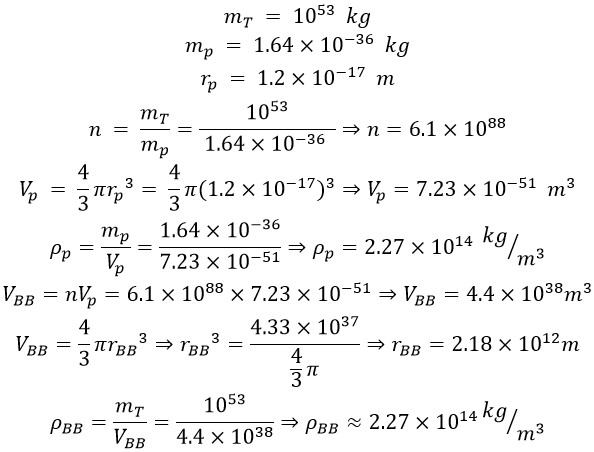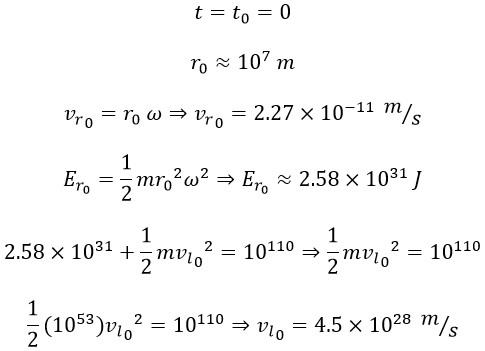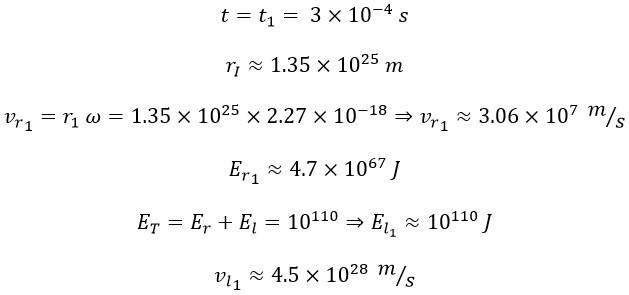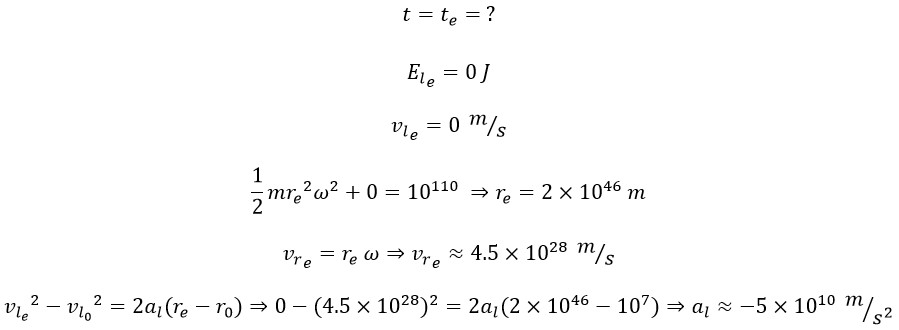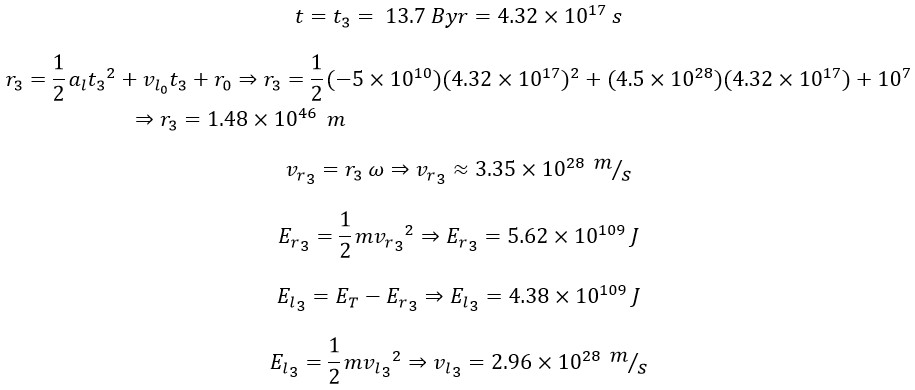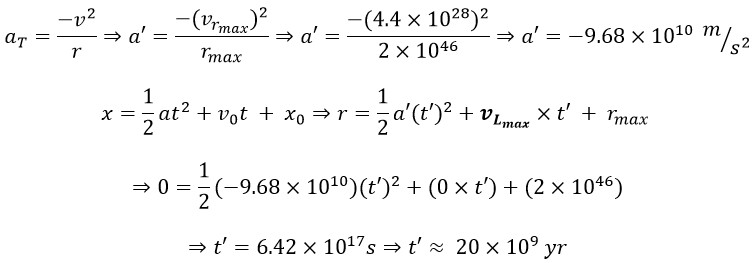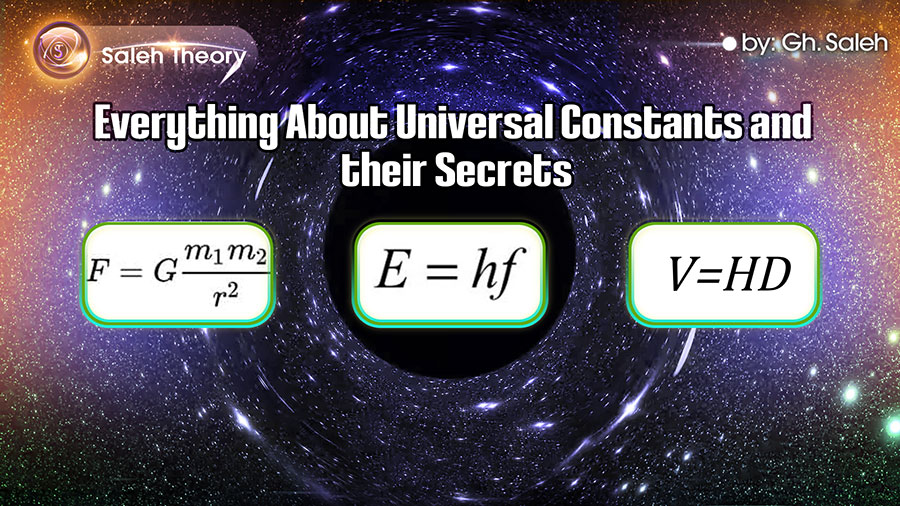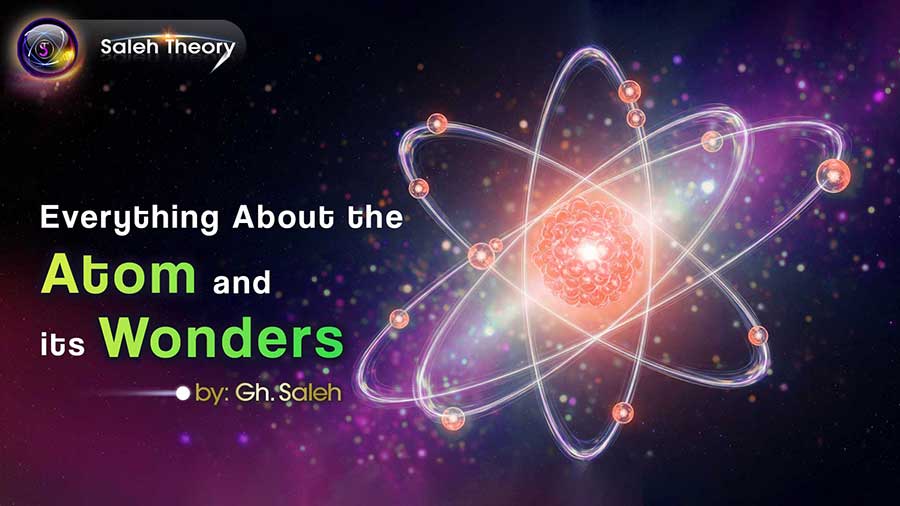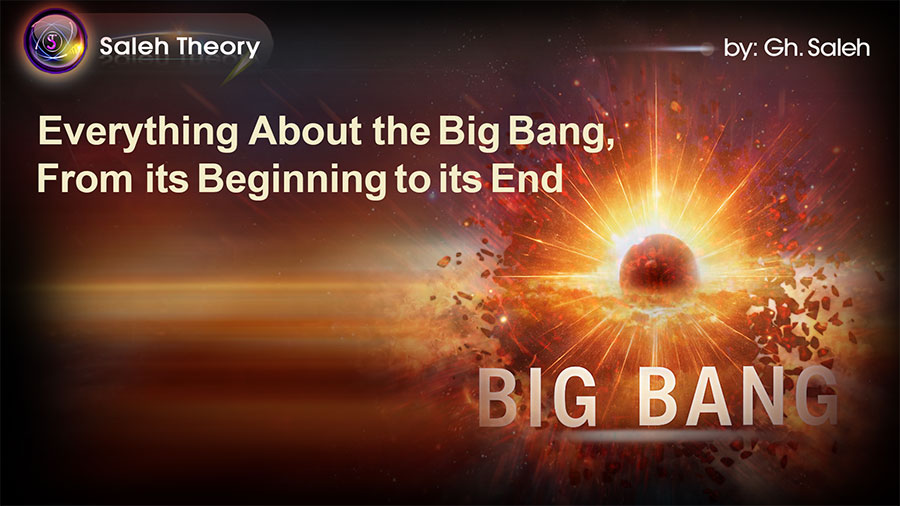
Everything About the Big Bang, From its Beginning to its End
The Big Bang is a tangible, real phenomenon, not merely a theory or hypothesis. It is argued that the equations of linear and rotational motion hold true for this event, implying that the Big Bang has a beginning, an end, and a repeatable cycle. According to Hubble's law, the universe has been rotating around its centre since the initial moments of the Big Bang, and this rotation, combined with linear motion, has caused the universe to expand.
1. Before the Big Bang
It is suggested that the time before the Big Bang can be conceived and measured. Based on calculations, approximately five Big Bang cycles have already occurred in our universe. It's posited that the lifetime of a Big Bang cycle is a fleeting moment when compared to the lifetimes of fundamental particles. For example, subatomic particles are said to have lifespans of roughly 1018 to 1020 years. If a Big Bang event's full duration from start to finish is about 40 billion years, its lifespan is considered little more than a spark compared to the actual lifespan of these particles. Therefore, subatomic particles must have existed for billions of years before the start of the current Big Bang cycle. In essence, the Big Bang is seen as a real phenomenon created from a previous one, just as galaxies are created by prior events and continue their existence.
The entire duration of a Big Bang event—from beginning to end—is considered a tiny spark relative to the time before and after it. In terms of mass, it's just a minuscule particle among all existing masses, and in terms of volume, a tiny point in infinite space.
2. The Structure and Formation of the Universe after the Big Bang
Considering experiments similar to the explosion of a sphere full of particles, after the Big Bang, the early space of the universe became shaped like a very large, rotating sphere that contains particles of a wide variety of densities, from the smallest to the largest. This sphere, referred to as "uni-mom," contained particles of diverse densities, from the smallest to the largest, including electrons and protons, and even highly dense particles like Cidtonium or supermassive black holes.
Previous theories suggested that elements were produced inside stars and released during stellar explosions. However, the Big Bang itself is considered an immense explosion—a "mother star" with a density of 1040 kg⁄m3 capable of creating any element or component. It is claimed that over 50% of all elements, fundamental particles, and everything else were formed within "uni-mom." In this view, the Big Bang is the "super sun" of black holes, and black holes are the "super suns" of stars.
3. The Volume and Density of the Big Bang
By examining the smallest known particle, the photon, and the total mass of the universe (about 1053 kg), it is argued that the photon cannot be the main constituent particle of the Big Bang. The resulting volume from such a calculation is deemed unacceptable for the Big Bang phenomenon.
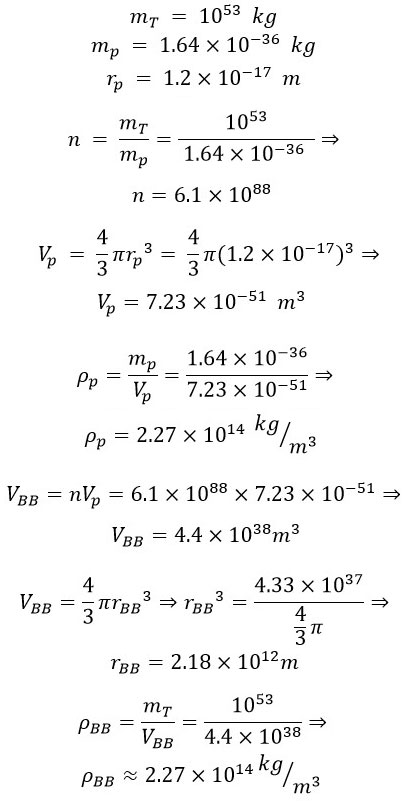
So, a smaller particle called the "sub-photon" or "Cidtonium" is introduced, with a radius one billionth that of a photon. Its proposed density is over 1041 kg⁄m3 , and its volume is less than 10-78 m3. Just as nucleons are packed together in heavy objects like black holes and magnetars without forming an atomic structure, it is suggested that these sub-photons (Cidtonium) were packed together to form the initial structure of the Big Bang. Based on this particle, the Big Bang's density would be slightly above 1041 kg⁄m3 , and its volume no less than 1010 kg⁄m3 . Here, the density and volume of Cidtonium and the Big Bang are calculated assuming that Cidtonium is the constituent particle:
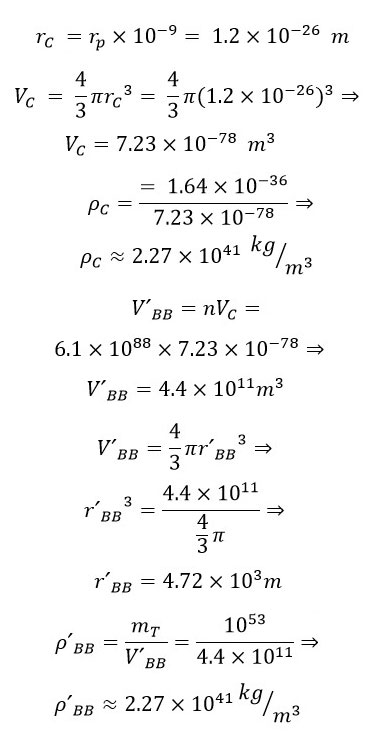
4. The Initial Separated Particles After the Explosion
As a result of the explosion, billions of black holes with a density of about 1020 kg⁄m3 have been released. Fundamental particles such as protons and electrons were also created, forming the basic structure of the hydrogen atom, the simplest element in the universe. Many photons and sub-photons were also released, with a smaller total mass than the other objects combined.
5. The Big Bang Mechanism: From Creation to Explosion
The Big Bang consists of three main stages:
I. First stage: An initial collision where objects like black holes collide to form a larger, dense "super black hole." This mass collapses inwards at a high initial velocity, reaching a volume that is a fraction of the Moon's. The kinetic energy of the Big Bang is attributed to an impulse: a collection of compressed masses at a central point strikes each other, and the resulting reaction starts the explosion of the extremely dense Big Bang mass.
II.Second stage: In this stage, we have an extremely compacted mass with a density of about 1050 kg⁄m3 , which returns in some extent, and its volume becomes a value higher than the volume of the Moon, and its density will be about 1040 kg⁄m3 . At this moment, the Big Bang phenomenon begins with a huge explosion.
III. Third stage: In fact, it can be said that the dimension of this mass is slightly larger than the Moon, and it could not be able to maintain its structure longer. So, it undergoes an extremely intense explosion, marking the beginning of the universe's expansion.
The objects that are separated from that huge explosion are: black holes, protons and electrons. The released protons and electrons form the basic structure of the hydrogen atom. In fact, it can be said that the cosmic dust or gases are the same hydrogen atoms. At this stage, the Universe is dark because no light is released. To emit light, dust (gases) is compressed together and forms stars. Then black holes and stars form galaxies.
6. The Linear and Rotational Motions of the Universe
The linear motion (vl) is the result of the initial explosion and is said to decrease over time with negative acceleration. The velocity of particles decreases with increasing distance from the centre (similar to the explosion of a grenade, whose shrapnel does not travel to infinity), as there was an initial energy and no further linear energy is added to the system.

But the rotational motion (vr), however, is described as permanent and increasing. This is said to be confirmed by Hubble's law, which is interpreted here as representing the tangential speed and angular speed of the universe.

7. The Law of Conservation of Energy and Dark Energy
The total energy of the Big Bang is said to be the sum of linear and rotational energies. As the linear energy decreases, the rotational energy increases, which is proposed to explain the observed cosmic acceleration.
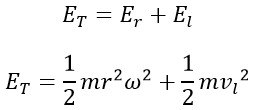
It is argued that scientists, having previously considered only linear motion in their models, observed that celestial objects' velocities increase over time, and the more distant they are, the faster they recede (according to Hubble's law). In response, they sought a "missing energy" to account for this acceleration, which they named dark energy.
However, by considering rotational energy and positing that Hubble's law represents tangential speed, it is suggested that dark energy is in fact the rotational energy, whose significance increases as linear energy decreases. Therefore, dark energy is defined as the total energy at the moment of the Big Bang minus the linear energy, which equals the previously overlooked rotational energy.

8. Calculated Tables of the Physical Parameters of the Universe
Using the principle of conservation of energy and the Monte Carlo method, the physical parameters of the universe (radius, velocity, energy) at key stages—from the Big Bang and the inflationary epoch to the present and its eventual end—have been calculated. It is predicted that the universe will reach zero linear velocity and maximum rotational energy approximately 29 billion years after the Big Bang.
At the moment of the Big Bang, the contribution of rotational energy was negligible and could be ignored. Therefore, at the time of the Big Bang, the total energy can be considered to arise entirely from linear motion:
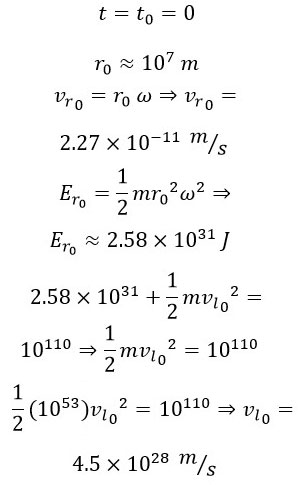
In the previous article, using the density of the universe, we have calculated the radius of the universe (r1)at the end of the inflationary phase. Thus, we have:

As indicated—and as discussed in previous articles—over time, the amount of linear energy decreases, and an equivalent amount is added to the rotational energy. This implies that at the end of the universe’s outward trajectory, when it reaches its maximum radius, all the energy will be converted into rotational energy, and the linear energy will reduce to zero
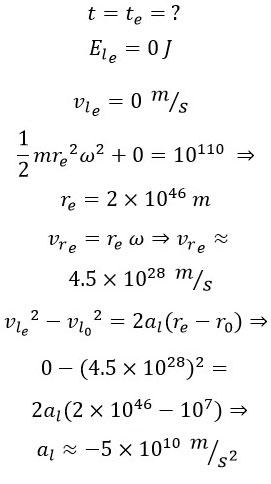
This represents the average deceleration that reduces the linear velocity (and consequently the linear energy). Thus, in linear motion, we observe a motion with constant negative acceleration
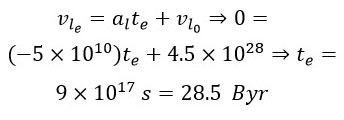
Next, we examine the time when the rotational and linear energies are equal:
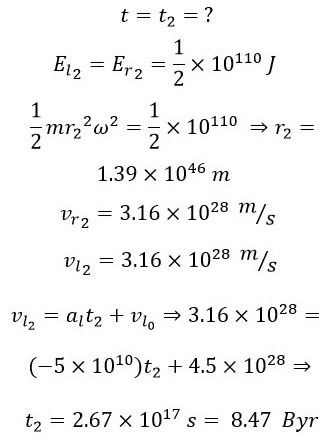
We now proceed to analyse the physical parameters of the universe at present.
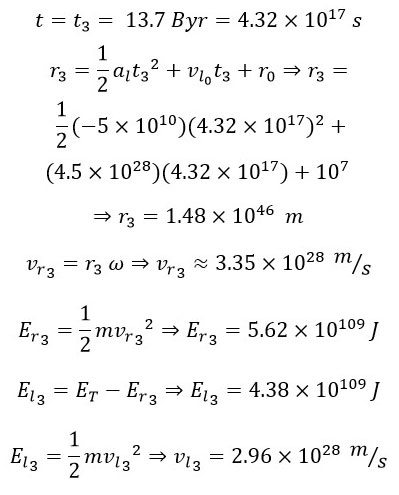

It is predicted that the universe will reach a linear stop point in approximately 29 billion years, at which time its rotation will be at a maximum, and a reverse cycle will begin.
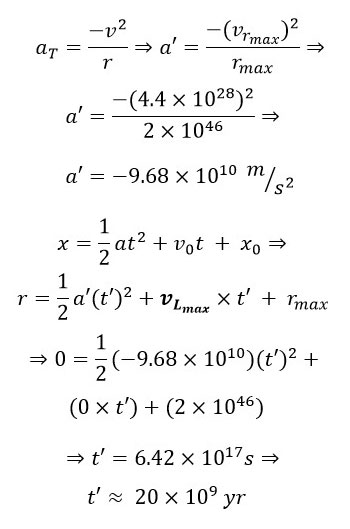
9. The Universe's Return and Repeating Cycles
The universe is presented as cyclic, returning to its starting point every 50 billion years, much like a compressed spring or the orbital motions of planets. These cycles of expansion and contraction are said to repeat, with the universe continuously expanding and then contracting.
Conclusion
The Big Bang is not just an explosive event but a real, cyclic phenomenon involving both linear and rotational motion. The fundamental particle of this event is a sub-photon called Cidtonium, which formed the initial structure of the universe. Dark energy is identified as the previously unknown rotational energy that plays a crucial role in the universe's evolution. Ultimately, the universe is said to have a cyclic lifespan of about 50 billion years, encompassing periods of expansion and contraction.
References:
[1] Gandolfi, Stefano, J. Carlson, and S. Reddy. “Maximum Mass and Radius of Neutron Stars, and the Nuclear Symmetry Energy.” Physical Review C, vol. 85, no. 3, 2012, p. 032801.
[2] Saleh, Gh. "Novel and Innovative Physics Equations for the Modern Era Part D) Astronomy." Saleh Theory, 03 Aug. 2025, https://saleh-theory.com/article/novel-and-innovative-physics-equations-for-the-modern-era-br-part-d-astronomy
[3] Saleh, Gh. "Calculation of Energy Conservation Equations Utilizing Linear and Rotational Energy in the Universe." Saleh Theory, 14 Jun. 2025, https://saleh-theory.com/article/calculation-of-energy-conservation-equations-utilizing-linear-and-rotational-energy-in-the-universe
[4] Saleh, Gh. "New Computational Table of Physical Parameters for the Moments of Beginning, Inflation, Present, and End of the Universe 2025." Saleh Theory, 29 Jan. 2025, https://saleh-theory.com/article/new-computational-table-of-physical-parameters-for-the-moments-of-beginning-inflation-present-and-end-of-the-universe-2025
[5] Saleh, Gh. "New Discoveries about the Source of Dark Energy, Its Nature, and More: Based on the Initial Energy of the Universe (Big Bang), Hubble's Law, and Its Governing Mathematical and Physical Equations (2025)." Saleh Theory, 10 Jan. 2025, https://saleh-theory.com/article/new-discoveries-about-the-source-of-dark-energy-its-nature-and-more-based-on-the-initial-energy-of-the-universe-big-bang-hubbles-law-and-its-governing-mathematical-and-physical-equations-2025
[6] Saleh, Gh. "Discovery of the Smallest Particle in the Universe, Cidtonium, Using the Big Bang Phenomenon." Saleh Theory, 04 Feb 2023, https://saleh-theory.com/article/discovery-of-the-smallest-particle-in-the-universe-cidtonium-using-the-big-bang-phenomenon
[6] Saleh, Gh. "Discovery of the Smallest Particle in the Universe, Cidtonium, Using the Big Bang Phenomenon." Saleh Theory, 04 Feb 2023, https://saleh-theory.com/article/discovery-of-the-smallest-particle-in-the-universe-cidtonium-using-the-big-bang-phenomenon
[12] Saleh, Gh. "New Calculation of the Time of the Universe from Beginning to End." Saleh Theory, 29 Aug. 2022, https://saleh-theory.com/article/new-calculation-of-the-time-of-the-universe-from-beginning-to-end
 Download PDF
Download PDF 
